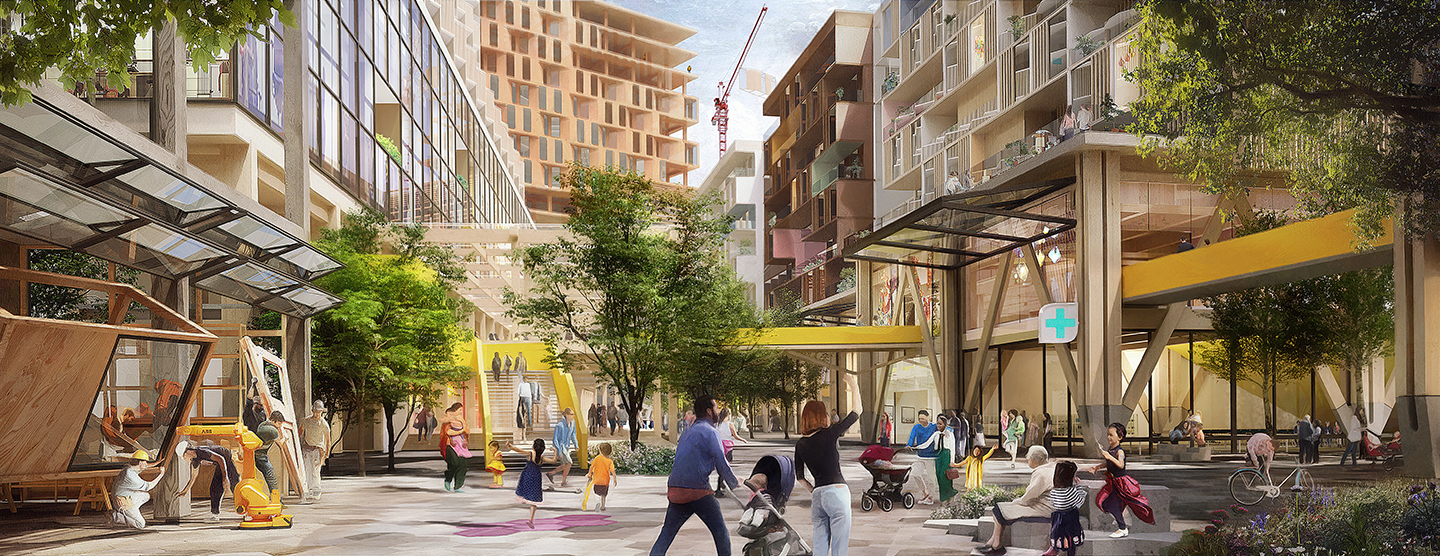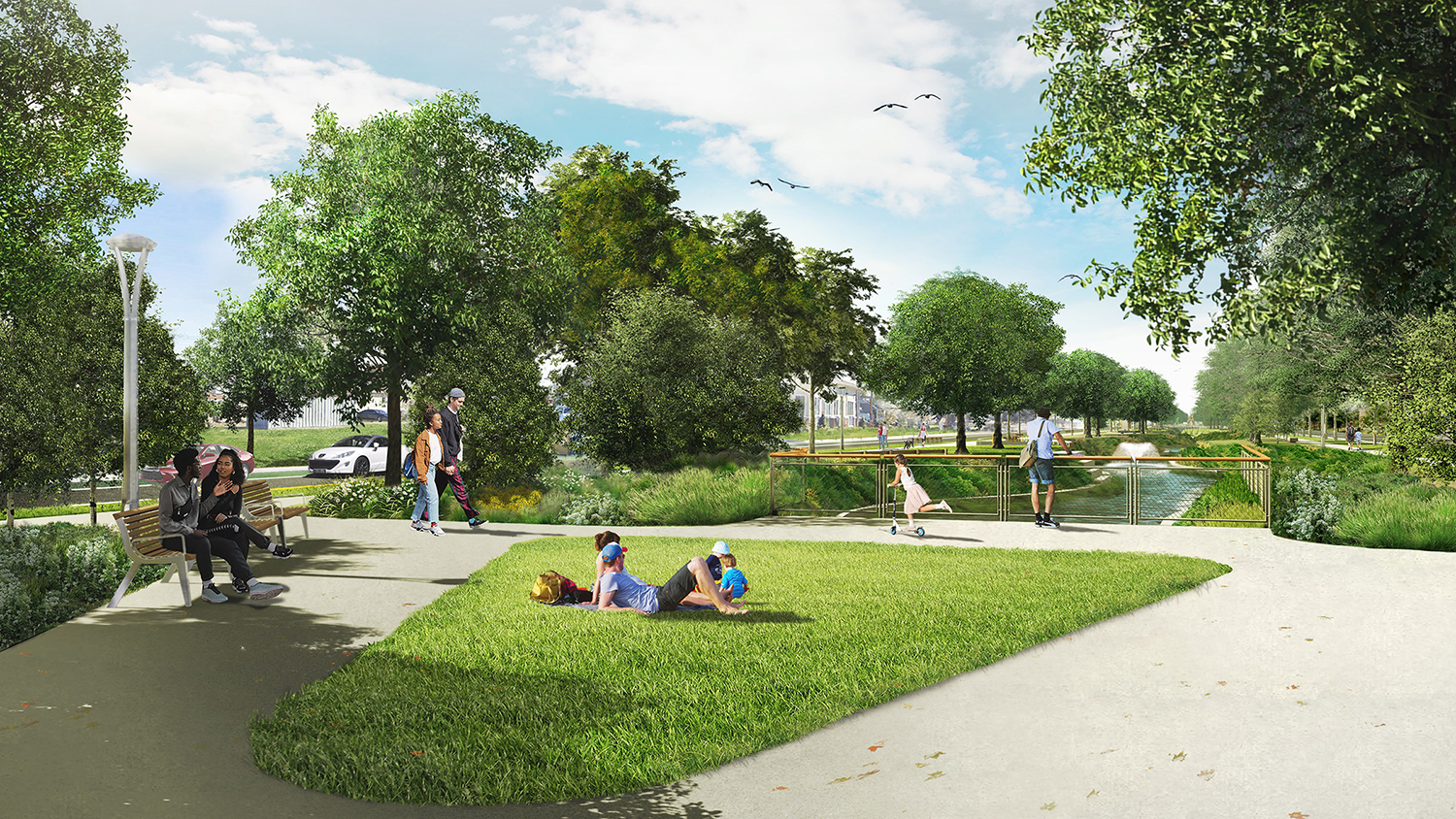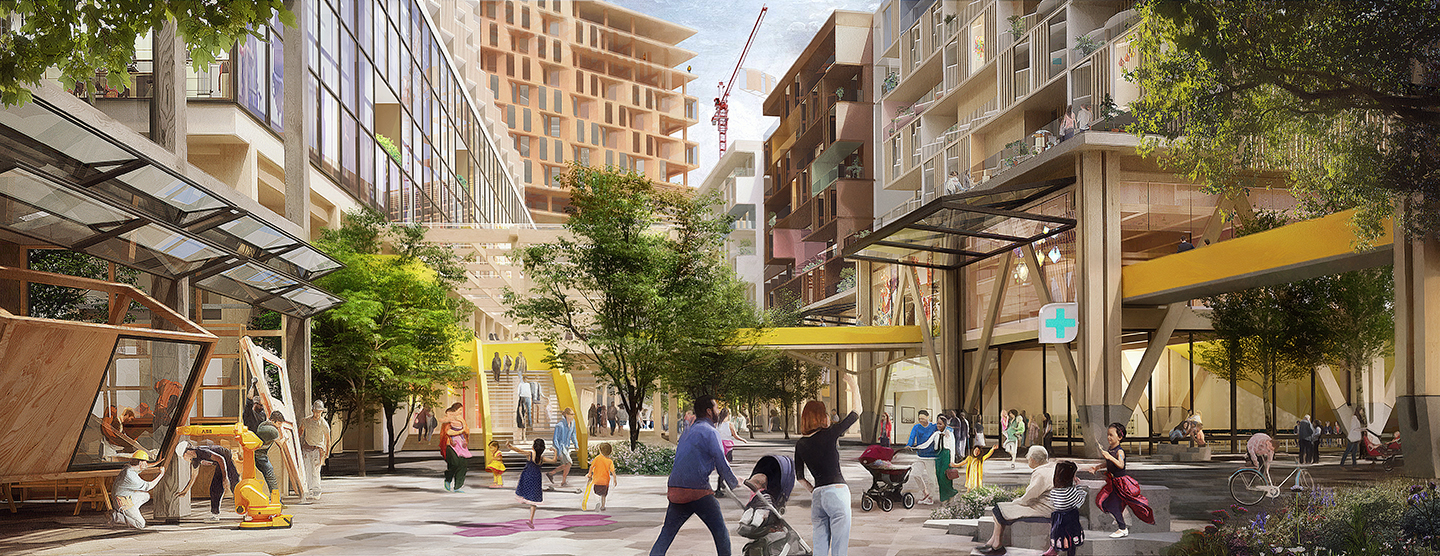The Greek philosopher Heraclitus said: “the only constant in life is change.” Nowhere is that more evident than in our cities. Pick just about any city, and it will seem both familiar and new at the same time. And not just major cities like New York or Chicago. Change is happening in cities big and small, urban and suburban. And it reaches beyond the recent expansions of mixed-use developments in formally monolithic areas like office parks and shopping centers.
It involves fundamental shifts based on strategic or philosophical principles on “how” and “why” we develop. Three strategies stand out as key trends in urban development: Innovation Districts, Blue Zones, and EcoDistricts.
1. Innovation Districts
As designers, we often speak about the benefit of “accidental collisions” between people in a workspace. That is the core principle behind an urban regeneration strategy called Innovation Districts—massive mixed-use developments with a variety of housing types to encourage a diverse population mix, combined with walkable mixed-use employment and retail areas.
Innovation Districts are characterized by two or more “anchor” locations, such as universities, hospitals, and research centers. Distributed throughout, Innovation Districts are also offices, retail, dining, and open greenspaces with a specific focus on a variety of transportation options, often favoring mass transit over cars. Think of it as a massive regional shopping mall, but for ideas and creativity.
This concept began in the early 2000’s with Barcelona’s 500-acre 22@Barcelona and Boston’s Seaport Innovation District. Other cities quickly followed, and more are added each year. The Brookings Institution’s “Initiative on Innovation and Placemaking” (funded by the billionaire Bass family of Fort Worth, Texas), seeks to create and monetize new ideas and grow metropolitan economies. The initiative is funding start-up Innovation Districts from London to Oklahoma City, Philadelphia, and Pittsburgh.
Innovation Districts encourage the distribution of people and ideas throughout the district. They include widespread and robust broadband Wi-Fi service so that people can continue to work and exchange ideas outside of traditional workspaces, promoting collaboration. Innovation Districts also promote complete streets, walkability, diverse housing, and a vibrant urban atmosphere. If that sounds familiar, it is basically how we built our cities prior to the suburban expansion of the Baby Boom years.
What’s more, they tend to be cool places to live. Stantec is working with Sidewalk Labs to create a new kind of community at Quayside—a 12-acre site on Toronto’s waterfront that borrows from many of the principals of an Innovation District. With underground tunnels for freight, utilities, gas lines, and a pneumatic waste-handling system, the design team freed up space to create a friendlier public realm while ensuring that infrastructure maintenance and upgrades can take place without disrupting the street. The design also puts people at the heart of sustainable mobility options. At Quayside, every building will have access to a bike share, an e-bike dock, and an e-scooter dock within a five-minute walk or less.

2. Blue Zones
Another unique approach to urban development promotes healthy living and longevity through a variety of design practices. Known as Blue Zones, these areas were born out of a concept derived from a National Geographic article that identified five reas across the globe where people live longer.
The article’s lead author, Dan Buettner, found that these communities had lower incidents of cancer and heart disease, fewer cases of dementia and Alzheimer’s disease, a higher percentage of the population in their 90s and 100s, and were generally happier. Using these findings, he outlined six principles to maximize health and longevity:
- Engage in moderate and regular physical activity
- Have a life purpose, with meaningful activity throughout life
- Reduce stress
- Have a moderate caloric intake consisting of a plant-based diet (semi-vegetarianism)
- Alcohol may be consumed, but in moderation
- Engage in family life, social life, and spirituality/religion
The principles of Blue Zones can be applied to urban design and can inform everything from adaptive reuse to ground-up new developments, including:
- Walkable environments to reduce the need for cars
- Increased vertical density and mixed-use diversity to encourage walking
- A mix of housing options to encourage a multi-generational population
- A mix of development types beyond residential and office spaces
- Local gathering places, parks, and plazas
- Locally owned farm-to-table restaurants
- Community gardens and rooftop gardens
- A variety of community events and programs on an ongoing basis
If this sounds familiar, it is. Again, before the Great Suburban Expansion, this is how our cities functioned. The City of Fort Worth (Texas) was the first to adopt Blue Zone principles on a citywide basis. Stantec is also working with West Villages (North Port, Florida) to develop it as a Blue Zone community, encompassing more than 10,000 acres, 33,700 homes, and 3-million-square-feet of commercial development.
Blue Zone principles represent good planning and can be incorporated into urban designs will little effort, especially in new greenfield developments. Cities with existing zoning ordinances and development regulations may be interested in revisiting those guidelines to see how they can incorporate Blue Zone principles into their own communities.

3. EcoDistricts
As designers, elected officials, and developers are increasingly focused incorporating sustainability practices into design, EcoDistricts are starting to become a priority for urban development. EcoDistricts fuse sustainable development principles with urban planning to reduce the ecological footprint of a development—essentially a large-scale application of LID low impact development (LID) to reduce a development’s carbon footprint and environmental impact.
While most EcoDistricts are predominantly located in Europe, Japan, and China, they are beginning to gain momentum in the US. Two EcoDistricts currently exist in the states (the Midtown Project in Atlanta and the Audubon Park Garden District in Orlando, Florida) with new projects planned or under development all the way from Seattle to Miami. EcoDistricts incorporate many of the same principles of the Living Building Challenge on a larger scale of a neighborhood or district, including:
- Multi-modality – supports lifestyles that promote pedestrian, bicycle, and transit use
- Water conservation – harvests rainwater, storm water, and condensate for reuse
- Alternative energy – uses solar, turbine, or other natural sources to generate energy
- Health – promotes health and encourages walking and resource sharing
- Building materials – avoids the use of hazardous materials
- Daylight equity – design workspaces within 30 feet of large, operable windows
- Aesthetics – architecture must be beautiful, innovative, contextually sensitive, and create a sense of neighborhood identity and ownership
Putting it all together: Cool, Blue, and Green
It is not necessary for each of these design principles to be distinct and separate. Envision an Innovation District that also incorporates Blue Zone and EcoDistrict design principles. Think of it as a Venn diagram with three overlapping circles moving closer and closer towards each other.
Since the start of the Baby Boom period, much of the US development has been pushing out toward the suburbs. In doing that, we also separated our land uses so much that walkability was all but forgotten. Land uses were vertically and horizontally separated based on land use codes developed in the 1920’s (the seminal zoning ordinance from Euclid, Ohio). The result? The only way to get around was to drive everywhere.
Today, walkability and access to green spaces are top selling points. Buyers want neighborhoods that offer new architecture, land-uses, and technology—areas that create “intelligent” density conducive to walking and biking, and that are less costly and more sustainable. Innovation Districts, Blue Zones, and EcoDistricts provide these characteristics and more. They offer neighborhoods that are interesting, safe, affordable for diverse income groups, and healthy.
The vertical and horizontal mixture of compatible land uses harkens back to old downtowns. Imagine a building with three or more uses, such as street-level retail, second-level office, and a third-level residential floor. Even putting compatible uses next to one another is a desirable attribute of today’s office campus. And cities that cannot offer these amenities find themselves on the losing end of new corporate relocations and expansions.
This is more than an urban design or development issue. It also involves changing development policy at the local level. Many suburbs had traditionally prohibited dense or mixed development except for a few select areas. But local zoning and development regulations can be amended to account for development that promotes Innovation Districts, Blue Zones, and EcoDistricts.
Implementing these urban development strategies can significantly reduce traffic, which is certainly less expensive than constantly widening local streets or building new highways. It can also result in a more efficient design approach, a more creative environment, and a healthier population. Consumer and employee expectations are changing and there is an increased desire for more diverse and walkable environments today. Coupled with maintaining a desirable quality of life is the attraction and retention of businesses and residents. It is an ever-increasing competitive market. And cities and suburbs that cannot (or do not) adapt, run the risk of being left behind.
Cool, Blue, and Green is not a trend. It is the smart way to build our communities.
More from Author
Stantec | Jul 18, 2024
Why decarbonizing hospitals smartly is better than electrification for healthcare design
Driven by new laws, regulations, tariffs, ESG goals, and thought leaders in the industry itself, healthcare institutions are embracing decarbonization to meet 2050 goals for emissions reductions.
Stantec | Jun 18, 2024
Could ‘smart’ building facades heat and cool buildings?
A promising research project looks at the possibilities for thermoelectric systems to thermally condition buildings, writes Mahsa Farid Mohajer, Sustainable Building Analyst with Stantec.
Stantec | Jun 8, 2024
8 ways to cool a factory
Whichever way you look at it—from a workplace wellness point of view or from a competing for talent angle—there are good reasons to explore options for climate control in the factory workplace.
Stantec | Apr 18, 2024
The next destination: Passive design airports
Today, we can design airports that are climate resilient, durable, long-lasting, and healthy for occupants—we can design airports using Passive House standards.
Stantec | Mar 18, 2024
A modular construction solution to the mental healthcare crisis
Maria Ionescu, Senior Medical Planner, Stantec, shares a tested solution for the overburdened emergency department: Modular hub-and-spoke design.
Stantec | Nov 20, 2023
8 strategies for multifamily passive house design projects
Stantec's Brett Lambert, Principal of Architecture and Passive House Certified Consultant, uses the Northland Newton Development project to guide designers with eight tips for designing multifamily passive house projects.
Stantec | Apr 10, 2023
Implementing human-centric design in operations and maintenance facilities
Stantec's Ryan Odell suggests using the human experience to advance OMSF design that puts a focus on wellness and efficiency.
Stantec | Jul 6, 2022
5 approaches to a net zero strategy that communities can start right now
Whether your community has started on a plan or is still considering net zero, now is the time for all of us to start seriously addressing climate change.
Stantec | Feb 14, 2022
5 steps to remake suburbs into green communities where people want to live, work, and play
Stantec's John Bachmann offers proven tactic for retrofitting communities for success in the post-COVID era.
Stantec | Feb 8, 2022
How gaming technology is changing the way we design for acoustics
Adding 3D sound from gaming engines to VR allows designers to represent accurate acoustic conditions to clients during design.
















